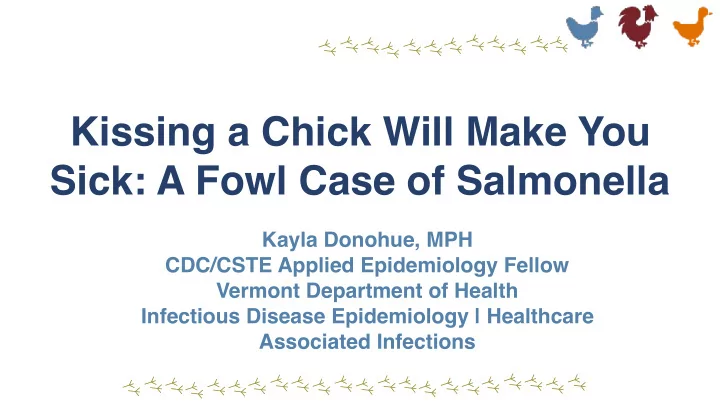

Kissing a Chick Will Make You Sick: A Fowl Case of Salmonella Kayla Donohue, MPH CDC/CSTE Applied Epidemiology Fellow Vermont Department of Health Infectious Disease Epidemiology | Healthcare Associated Infections
The Stars: Princess Laya, Hen Solo, Chewbwaka, Boba Feather, Kylo Hen, Rey, K2SO
Objectives: • Understand the prevalence of Salmonella associated with exposure to live baby poultry • Observe the trends in Vermont over time and consider the impact of Culture-Independent Diagnostic Testing (CIDT) • Understand behaviors that may increase the risk of contracting Salmonella • Identify populations at increased risk and explore potential interventions
What is Salmonella ? • Salmonellosis is an infection caused by Salmonella bacteria • 1.2 million illnesses and 450 deaths in US annually • Annual Incidence in US 15.2 illnesses per 100,000 individuals • Signs & Symptoms: • Acute gastroenteritis (mild to severe diarrheal illness) • Abdominal cramps, fever, nausea, vomiting, headache • ~ Severe and life-threatening complications ( 8%): • Extra-intestinal or invasive infections in bloodstream, bone, joint, brain, nervous system, etc.
How is it spread? Animals shed Young animals are more • Salmonella lives in the likely to shed pathogens pathogens intestinal tract of humans and animals Pathogens contaminate • Eating contaminated food or the environment drinking contaminated water • Touching infected animals Many pathogens have People exposed a low infectious dose to pathogens or their environments and not washing your hands afterwards Children are most at People get sick risk for serious illness
Trends in Vermont Salmonella infections in Vermont, 2011-2017 120 17% 8% 2% Number of Cases 4% 90 22% 7% 5% 60 30 0 2011 2012 2013 2014 2015 2016 2017 Category Title Poultry-Associated Non-Poultry Associated
Live Poultry Trends Salmonella infections associated with exposure to live poultry in the US Compared to Vermont, 2011-2017 1200 20 Number of Cases (US) Number of Cases (VT) 900 15 600 10 300 5 0 0 2011 2012 2013 2014 2015 2016 2017 Year VT Cases US Cases
Live Poultry Trends Salmonella infections associated with exposure to live poultry in Vermont, 2011-2017 22 Number of People 17 11 6 0 2011 2012 2013 2014 2015 2016 2017 Year
Laboratory Testing 80 of 173 Salmonella electronic lab results from 2016-2017 were from CIDT (46.75%) Timeliness: Date received Specimen by public health collection date CIDT (n=79): average 2.33 days (1-4 days) Culture (n=90): average 8.51 days (1-34 days)
Geographic Spread
By Age Category Salmonella infections by age category, 2011-2017 90 Number of Cases 68 45 23 0 Under 10 21-30 years 41-50 years 61-70 years Age Category Poultry Cases Non-Poultry Cases
Children Under 10 Percent of cases under 10 years of age, 2011-2017 50 42 % 38 25 17 % 13 0 Poultry Non-Poultry
A Closer Look at 2017 • As of 9/30/2017, N=18 • Median illness duration = 10 days (5-14 days) • 1 hospitalized (6%) • 14 reported live poultry exposure (78%) • 11 females (61%) • 10 Braenderup (56%), 7 Enteritidis (39%),1 Mbandaka (6%) • 5 were under the age of 10 (28%) • Median age at onset = 29 years (2 months-66 years) • 4 were from Orleans County (22%) • 2 were occupationally exposed (11%)
2016 Outbreak Confirmed Salmonella Cases Associated with Live Poultry Exposure Epidemic Curve, Vermont 2016 3 Number of Cases 2 2 1 0 2-Mar 11-Mar 20-Mar 29-Mar 7-Apr 16-Apr 25-Apr 4-May 13-May 22-May 31-May 9-Jun Onset Date
2017 Outbreak Confirmed Salmonella Cases Associated with Live Poultry Exposure Epidemic Curve, Vermont 2017 3 2 Cases 2 1 0 11-Apr 21-Apr 1-May 11-May 21-May 31-May 10-Jun 20-Jun 30-Jun 10-Jul 20-Jul 30-Jul 9-Aug Onset Date Braenderup Enteritidis Mbandaka
Risk Factors 14 exposed to live poultry 12 owned poultry and were exposed at home (86%) 8 kept poultry inside their home (67%)
Risk Factors
Risk Factors • 10/13 (77%) said they were aware of the a connection between poultry contact and Salmonella • 8/13 (62%) said they “Always (95-100%)” preformed hand hygiene directly after handling live poultry • 10/13 (77%) touched the poultry and/or cleaned the cages • 2 reported only indirect contact • 11/12 (92%) had baby poultry, purchased this year • 2/11 (18%) had less than 1 year experience raising poultry
Conclusions • Live poultry-associated Salmonella outbreaks seem to be on the rise • Rural/suburban areas in Vermont • Children under the age of 10 years • Keeping chicks inside your home • What can we do? • Targeted interventions - education, HH, feed stores • Lab testing • Climate change
Thank You! Bradley Tompkins, MPH Patsy Kelso, PhD Veronica Fialkowski, MPH Laurin Kasehagen, PhD CDC Salmonella Outbreak Team Kayla Donohue, MPH kayla.donohue@partner.vermont.gov 802-863-7329 This study/report was supported in part by an appointment to the Applied Epidemiology Fellowship Program administered by the Council of State and Territorial Epidemiologists (CSTE) and funded by the Centers for Disease Control and Prevention (CDC) Cooperative Agreement Number 1U38OT000143-02
Recommend
More recommend